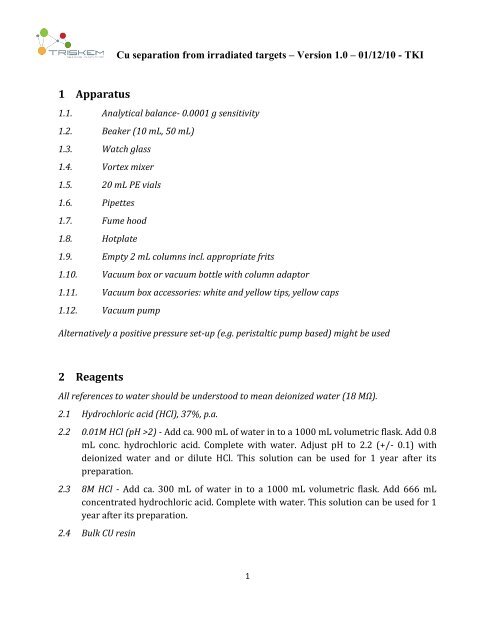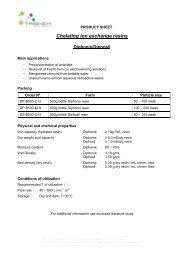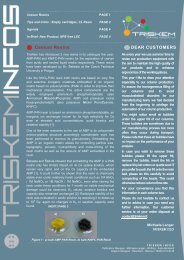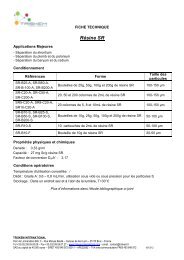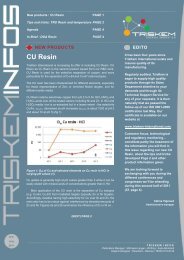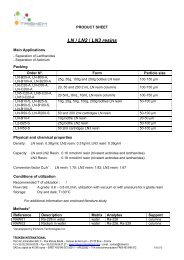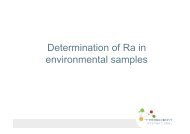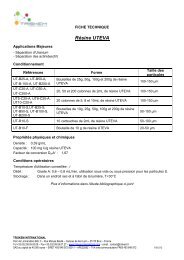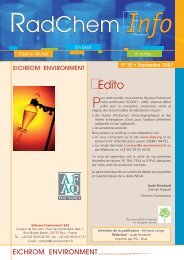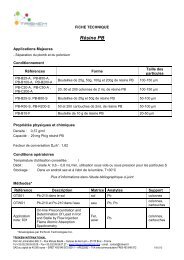1 Apparatus 2 Reagents - TrisKem International
1 Apparatus 2 Reagents - TrisKem International
1 Apparatus 2 Reagents - TrisKem International
You also want an ePaper? Increase the reach of your titles
YUMPU automatically turns print PDFs into web optimized ePapers that Google loves.
Cu separation from irradiated targets – Version 1.0 – 01/12/10 - TKI<br />
1 <strong>Apparatus</strong><br />
1.1. Analytical balance- 0.0001 g sensitivity<br />
1.2. Beaker (10 mL, 50 mL)<br />
1.3. Watch glass<br />
1.4. Vortex mixer<br />
1.5. 20 mL PE vials<br />
1.6. Pipettes<br />
1.7. Fume hood<br />
1.8. Hotplate<br />
1.9. Empty 2 mL columns incl. appropriate frits<br />
1.10. Vacuum box or vacuum bottle with column adaptor<br />
1.11. Vacuum box accessories: white and yellow tips, yellow caps<br />
1.12. Vacuum pump<br />
Alternatively a positive pressure set-up (e.g. peristaltic pump based) might be used<br />
2 <strong>Reagents</strong><br />
All references to water should be understood to mean deionized water (18 MΩ).<br />
2.1 Hydrochloric acid (HCl), 37%, p.a.<br />
2.2 0.01M HCl (pH >2) - Add ca. 900 mL of water in to a 1000 mL volumetric flask. Add 0.8<br />
mL conc. hydrochloric acid. Complete with water. Adjust pH to 2.2 (+/- 0.1) with<br />
deionized water and or dilute HCl. This solution can be used for 1 year after its<br />
preparation.<br />
2.3 8M HCl - Add ca. 300 mL of water in to a 1000 mL volumetric flask. Add 666 mL<br />
concentrated hydrochloric acid. Complete with water. This solution can be used for 1<br />
year after its preparation.<br />
2.4 Bulk CU resin<br />
1
Cu separation from irradiated targets – Version 1.0 – 01/12/10 - TKI<br />
3 Procedure<br />
3.1 Column preparation:<br />
3.1.1 Weigh 0.35g of the resin into a 20 mL PE vial<br />
3.1.2 Add 5 mL of 0.01M HCl (pH >2) solution and allow resin to soak for at least 30 min,<br />
preferably while shaking<br />
3.1.3 Allow 2 mL standard column and frits to soak in water for at least 30 min<br />
3.1.4 Place appropriately sized containers in vacuum box, place lid on top of box. Into<br />
each of the holes of the box tightly fit yellow tips, into these tightly fit white tips.<br />
3.1.5 Empty soaked columns. Fix appropriate number of empty 2 mL standard column<br />
onto white tips, close remaining white tips with yellow caps.<br />
3.1.6 Transfer soaked resin into empty column and turn vacuum on. Allow liquid to pass<br />
the column, then turn vacuum off.<br />
3.1.7 Add 4 mL of 0.01M HCl (pH >2) solution onto the column and turn vacuum on. Allow<br />
liquid to pass the column, turn vacuum off. Repeat until column is tightly packed and<br />
free of bubbles and channels (max. 5 times). Place frit on top of resin.<br />
Note: The columns can run dry, but shouldn’t stand dry for prolonged time (> 10 min). In case a<br />
column is not used immediately add another 4 mL of 0.01M HCl (pH >2) on top of the column, turn on<br />
vacuum and allow approx 2 mL of the solution to pass. Turn off vacuum and close lower and upper<br />
end of column (e.g. with ParaFilm). The so prepared column might be stored for several days<br />
(preferably at room temperature and in the dark).<br />
3.1.8 Preconditioning of the column.<br />
A freshly prepared column can be considered as preconditioned. In case a column has been<br />
stored for prolonged time it is preferable to precondition the column anew. To do so place<br />
column on prepared vacuum box, turn on vacuum and allow solution contained in the<br />
column to pass the column. Add 4 mL of fresh 0.01M HCl (pH >2) and allow to pass.<br />
Note: The column rinsing can be done at a flow rate of up to 3 mL/min<br />
2
Cu separation from irradiated targets – Version 1.0 – 01/12/10 - TKI<br />
3.2 Loading solution preparation:<br />
3.2.1 Dissolve irradiated target.<br />
Note: For Ni targets you might use the following method: Place irradiated Ni foil into an appropriate<br />
container and place container on hotplate. Add 1 mL 6M HCl per 100 mg of Ni foil and cover container<br />
with watch glass. Heat solution while stirring. Add H 2O 2 drop wise until target is dissolved (approx.<br />
0.7 mL H 2O 2 (30%) per 100 mg Ni foil, depending on thickness of the foil).<br />
3.2.2 Evaporate obtained solution to dryness. Rinse beaker and watch glass with water<br />
and re-evaporate. Dissolve residue in 1 mL of 0.01M HCl (pH >2) solution.<br />
3.3 CU separation:<br />
3.3.1 Place appropriately sized and labeled container below the columns<br />
3.3.2 Transfer solution onto prepared CU resin column.<br />
3.3.3 Rinse container with 1 mL 0.01M HCl (pH >2) solution, transfer solution onto the<br />
same CU resin column.<br />
3.3.4 Turn on vacuum, adjust flow rate to ≤ 1 mL/min and allow solution to pass column.<br />
3.3.5 Add 5 mL of 1 mL of 0.01M HCl (pH >2) solution onto the column and adjust flow<br />
rate to ≤ 6 mL/min. Allow solution to pass.<br />
Note: The container contains approx. 100% of the target material at this stage and might be removed<br />
for Ni recovery and replaced by a fresh container.<br />
3.3.6 Add 3 mL of 0.01M HCl (pH >2) solution onto the column and allow solution to pass<br />
at a flow rate of ≤ 6 mL/min. Turn off vacuum.<br />
3.3.7 Place fresh, labeled, appropriately sized container below column<br />
3.3.8 To elute the Cu-64 add 1 – 1.5 mL of 8M HCl onto the column. Turn on vacuum,<br />
adjust flow rate to 1mL/min. Allow solution to pass.<br />
Note: In some cases the Cu eluate might be too acidic for direct use, in this case it might need to be<br />
converted to lower acid concentration or neutral media this can either be done via an<br />
evaporation/redissolution step or via an anion exchange step as describedin 3.4.<br />
3.4 Optional: Cu eluate conversion via anion exchange<br />
3.4.1 Per Cu eluate to be converted weigh 400 mg anion exchange resin into a 20 mL PE vial.<br />
3.4.2 Add 5 mL of 0.1M HCl and allow resin to soak min. 30 min.<br />
3
Cu separation from irradiated targets – Version 1.0 – 01/12/10 - TKI<br />
3.4.3 For each Cu eluate to be converted place one empty 2 mL column in an appropriate rack.<br />
Allow column to soak in water for at least 30 min.<br />
3.4.4 Transfer soaked resin into emptied soaked column and allow the resin to settle. Place<br />
container below column and break lower tip. Allow solution to pass column.<br />
3.4.5 Subsequently rinse column with 2mL 2M HCl, then 2 mL 4M and at last 2 mL 8M HCl. The<br />
column is conditioned and ready for use. Place fresh container below the column.<br />
3.4.6 Carefully transfer the Cu eluate on top of the AIX column without perturbing the resin bed.<br />
Allow solution to pass through the resin at gravitational flow.<br />
Note: The separation might also be performed using vacuum or positive pressure set-ups, flow rates<br />
should be kept below 1 mL/min anyhow.<br />
3.4.7 Rinse container that contained the Cu eluate with 0.6 mL 8M HCl, transfer rinsing solution<br />
onto column. Allow solution to pass through the resin at gravitational flow.<br />
3.4.8 Rinse resin with max. 0.2 mL deionized water. Allow solution to pass through the resin at<br />
gravitational flow. Place fresh, labeled, appropriately sized container below column.<br />
3.4.9 Elute Cu using 0.6 – 0.8 mL of deionised water or saline solution<br />
4
Cu separation from irradiated targets – Version 1.0 – 01/12/10 - TKI<br />
3.5 Synopsis of the separations<br />
3.5.1 Cu separation on CU resin<br />
3.5.2 Cu eluate conversion on AIX resin<br />
5
Cu separation from irradiated targets – Version 1.0 – 01/12/10 - TKI<br />
4 References<br />
(1) C. Dirks, B. Scholten, S. Happel, A. Zulauf, A. Bombard, H. Jungclas: Characterisation of a Cu selective resin<br />
and its application to the production of 64Cu. J Radioanal. Nucl. Chem, 286 (2010) 671-674, DOI<br />
10.1007/s10967-010-0744-9, (2010). <strong>TrisKem</strong> reference: T-DC110.<br />
(2) C. Dirks, S. Happel: Characterization of a Cu selective resin and its application to the production of Cu-64.<br />
Presentation at the <strong>TrisKem</strong> <strong>International</strong> users group meeting, 14/09/2010, Chester (UK); available<br />
online: http://www.triskem-international.com/iso_album/ugm_chester_10_dirks_happel_cu_resin.pdf<br />
(3) Diploma thesis C. Dirks: Charakterisierung eines extraktionschromatographischen Harzes zur selektiven<br />
Kupfer Trennung. Philipps-University Marburg December 2010. <strong>TrisKem</strong> reference: T-DC210.<br />
6


